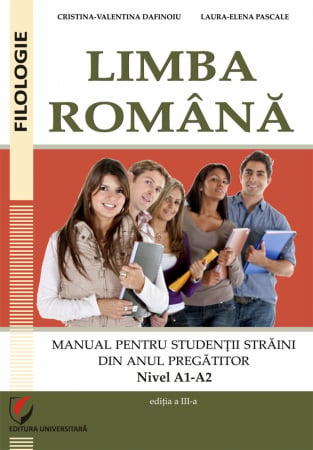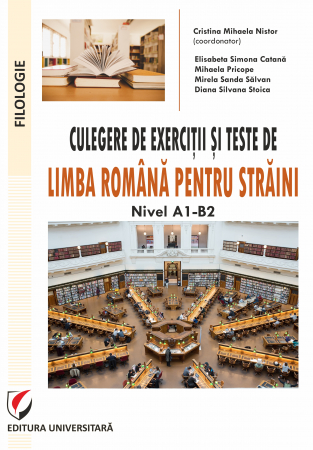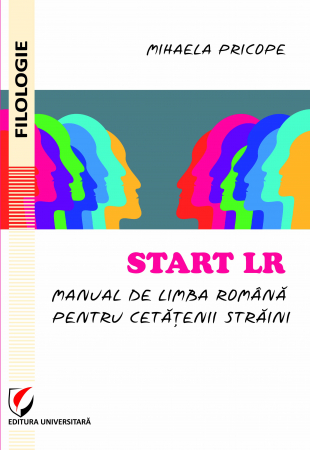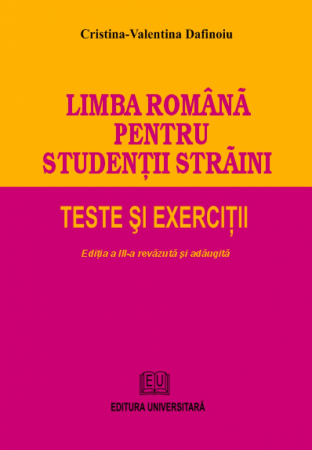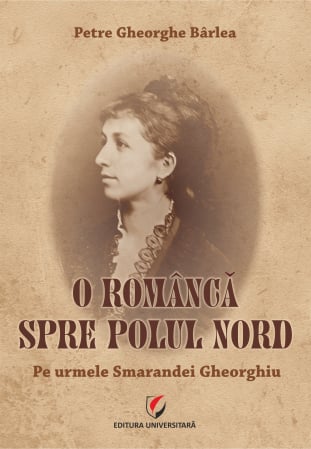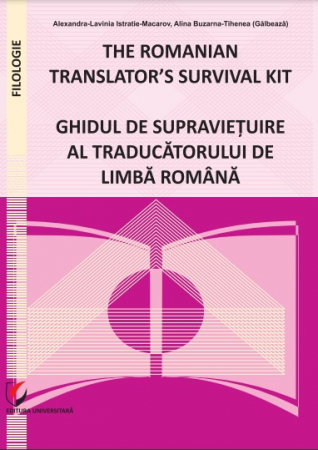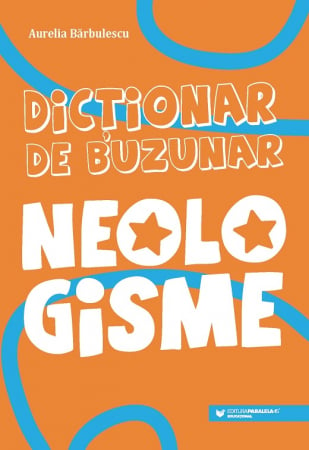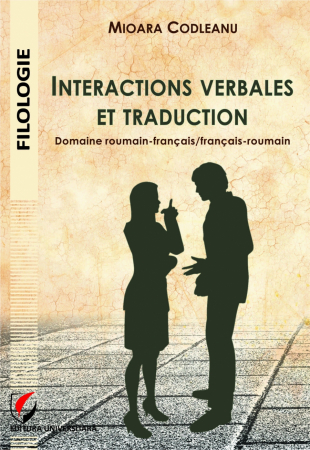Manuscript proposals: [email protected] / 0745 204 115 //// Tracking orders Individuals / Sales: 0745 200 357 / Orders Legal entities: 0721 722 783
6359.png) Borrowings from Turkish in the Aromanian and Megleno-Romanian dialects with reference to the Daco-Romanian dialect - Alecsandra Ciocarlan
Borrowings from Turkish in the Aromanian and Megleno-Romanian dialects with reference to the Daco-Romanian dialect - Alecsandra Ciocarlan
6359.png)
Publisher: Editura Universitară
Author: Alecsandra Ciocarlan
Edition: I
Pages: 374
Publisher year: 2023
ISBN: 978-606-28-1636-0
DOI: https://doi.org/10.5682/9786062816360
Product Code:
9786062816360
Do you need help?
0745 200 357
- Description
- Download (1)
- Authors
- Content
- More details
- Reviews (0)
The present volume is the result of the research undertaken within the doctoral school of the University of Bucharest.
The originality of the work consists in the use of the material made available by the dialect monographs, which has not been exploited until now, for a constructive-comparative research of the Dacoroman, Romanian and Meglenoroman dialects. During the course of the work, the motivation becomes very important for Romanian-Turkish linguistic relations, for the influence of Turkish borrowings in the Aromanian and Megleno-Romanian dialects with reference to the Daco-Romanian dialect.
The spatial perspective on the borrowings from Turkish in the Aromanian and Megleno-Romanian dialects, spoken in the Balkan space, was outlined based on the analysis of the Linguistic Atlas of the Aromanian dialect, vol. I, author Nicolae Saramandu, editor Manuela Nevaci. For the current work, I analyzed 18 maps. From the lexical diversity mapped on the maps, we demonstrated the unity of the Romanian language at the level of the Aromanian dialect and we were able to create a detailed picture of the geographical distribution of Turkish borrowings on the entire network, which includes 61 survey points.
Author
The originality of the work consists in the use of the material made available by the dialect monographs, which has not been exploited until now, for a constructive-comparative research of the Dacoroman, Romanian and Meglenoroman dialects. During the course of the work, the motivation becomes very important for Romanian-Turkish linguistic relations, for the influence of Turkish borrowings in the Aromanian and Megleno-Romanian dialects with reference to the Daco-Romanian dialect.
The spatial perspective on the borrowings from Turkish in the Aromanian and Megleno-Romanian dialects, spoken in the Balkan space, was outlined based on the analysis of the Linguistic Atlas of the Aromanian dialect, vol. I, author Nicolae Saramandu, editor Manuela Nevaci. For the current work, I analyzed 18 maps. From the lexical diversity mapped on the maps, we demonstrated the unity of the Romanian language at the level of the Aromanian dialect and we were able to create a detailed picture of the geographical distribution of Turkish borrowings on the entire network, which includes 61 survey points.
Author
-
Imprumuturile din turca in dialectele aroman şi meglenoroman cu raportare la dialectul dacoroman
Download
ALECSANDRA CIOCARLAN
List of abbreviations / 7
Argument / 9
CHAPTER I ROMANO-TURKISH LINGUISTIC RELATIONS. CURRENT STAGE OF RESEARCH / 15
I.1. Definitions. Conceptualizations / 15
I.1.1. Linguistic contact and extralinguistic favoring factors / 15
I.1.2. Borrowing – mark of linguistic relationships / 18
I.1.3. The reverse side of the cultural loan / 24
I.1.4. Linguistic calculation and borrowing. Definition. Classifications / 26
I.2. Borrowing from Turkish in the Aromanian and Megleno-Romanian dialects – the mark of linguistic contact. Theoretical aspects / 30
I.2.1. The lexical domains analyzed in the Aromanian dialect / 30
I.2.2. The lexical domains analyzed in the Megleno-Romanian dialect / 35
CHAPTER II COMPARATIVE ANALYSIS REGARDING THE SEMANTIC VARIANTS IN THE AROMAN, DACOROMAN AND MEGLENOROMAN DIALECTS, AT THE LEXICAL LEVEL / 42
II.1. Lexical domains / 42
II.2. Contrastive - comparative analysis of borrowings from Turkish in the Aromanian and Megleno-Romanian dialects with reference to the Daco-Romanian dialect, in the fields of military, construction, gastronomy and clothing / 43
II.2.1. The 'ARMY' domain / 43
II.2.2. The field 'CONSTRUCTIONS' / 95
II.2.3. The 'GASTRONOMY' field / 151
II.2.4. The 'CLOTHING' domain / 193
II.3. Statistical conclusions / 235
CHAPTER III BORROWINGS FROM THE TURKISH LANGUAGE IN THE AROMAN DIALECT FROM THE PERSPECTIVE OF LINGUISTIC GEOGRAPHY / 239
III.1. Borrowings from the Turkish language from the perspective of linguistic geography based on ALAR 1 / 239
III.2. Description of the Linguistic Atlas of the Aromanian dialect, vol. I, [ALAR] / 240
III.3. The investigation network in ALAR / 242
III.4. Maps from ALAR I with borrowings from the Turkish language / 243
III.4.1. Map 5. BUMP [62] / 243
III.4.2. Map 24. BALD [92] / 246
III.4.3. Map 35. GLASSES [114] / 250
III.4.4. Map 37. BLIND [117] / 253
III.4.5. Map 38. BLIND [119] / 255
III.4.6. Map 39. SQUINTING [121] / 257
III.4.7. Map 42. ALBEATA [125] / 261
III.4.8. Map 53. EARRING [137] / 264
III.4.9. Map 68.HANDKERCHIEF [156] / 266
III.4.10. Map 95. NOISE [228] / 269
III.4.11. Map 125. BARBER [262] / 272
III.4.12. Map 128. GLABROUS [265] / 274
III.4.13. Map 168. HUMP [309] / 276
III.4.15. Map 169. HUNCHED [310] / 279
III.4.16. Map 180. KIDNEYS [322] / 283
III.4.13. Map 184. CRIPPLED [327] / 286
III.4.17. Map 255. PILL [453] / 290
III.4.18. Map 268. UIMA [453] / 293
CONCLUSIONS / 297
ANNEXES / 302
Annex I. Comparative analysis of the semantic variants in the Aromanian and Dacoroman dialects, for words of Turkish origin / 302
Appendix II. Tables: Contrastive - comparative analysis of dialects, by domains / 304
II.1. The 'ARMY' domain / 304
II.2. The 'CONSTRUCTIONS' field / 315
II.3. The field 'GASTRONOMY' / 326
II.4. Domain 'CLOTHING' / 337
Appendix III. Table - Results of the investigation 347
Appendix IV. Table - Terms introduced into the Aromanian and Megleno-Romanian dialects, from Turkish from other languages / 359
Phonetic transcription / 363
BIBLIOGRAPHY / 367
Argument / 9
CHAPTER I ROMANO-TURKISH LINGUISTIC RELATIONS. CURRENT STAGE OF RESEARCH / 15
I.1. Definitions. Conceptualizations / 15
I.1.1. Linguistic contact and extralinguistic favoring factors / 15
I.1.2. Borrowing – mark of linguistic relationships / 18
I.1.3. The reverse side of the cultural loan / 24
I.1.4. Linguistic calculation and borrowing. Definition. Classifications / 26
I.2. Borrowing from Turkish in the Aromanian and Megleno-Romanian dialects – the mark of linguistic contact. Theoretical aspects / 30
I.2.1. The lexical domains analyzed in the Aromanian dialect / 30
I.2.2. The lexical domains analyzed in the Megleno-Romanian dialect / 35
CHAPTER II COMPARATIVE ANALYSIS REGARDING THE SEMANTIC VARIANTS IN THE AROMAN, DACOROMAN AND MEGLENOROMAN DIALECTS, AT THE LEXICAL LEVEL / 42
II.1. Lexical domains / 42
II.2. Contrastive - comparative analysis of borrowings from Turkish in the Aromanian and Megleno-Romanian dialects with reference to the Daco-Romanian dialect, in the fields of military, construction, gastronomy and clothing / 43
II.2.1. The 'ARMY' domain / 43
II.2.2. The field 'CONSTRUCTIONS' / 95
II.2.3. The 'GASTRONOMY' field / 151
II.2.4. The 'CLOTHING' domain / 193
II.3. Statistical conclusions / 235
CHAPTER III BORROWINGS FROM THE TURKISH LANGUAGE IN THE AROMAN DIALECT FROM THE PERSPECTIVE OF LINGUISTIC GEOGRAPHY / 239
III.1. Borrowings from the Turkish language from the perspective of linguistic geography based on ALAR 1 / 239
III.2. Description of the Linguistic Atlas of the Aromanian dialect, vol. I, [ALAR] / 240
III.3. The investigation network in ALAR / 242
III.4. Maps from ALAR I with borrowings from the Turkish language / 243
III.4.1. Map 5. BUMP [62] / 243
III.4.2. Map 24. BALD [92] / 246
III.4.3. Map 35. GLASSES [114] / 250
III.4.4. Map 37. BLIND [117] / 253
III.4.5. Map 38. BLIND [119] / 255
III.4.6. Map 39. SQUINTING [121] / 257
III.4.7. Map 42. ALBEATA [125] / 261
III.4.8. Map 53. EARRING [137] / 264
III.4.9. Map 68.HANDKERCHIEF [156] / 266
III.4.10. Map 95. NOISE [228] / 269
III.4.11. Map 125. BARBER [262] / 272
III.4.12. Map 128. GLABROUS [265] / 274
III.4.13. Map 168. HUMP [309] / 276
III.4.15. Map 169. HUNCHED [310] / 279
III.4.16. Map 180. KIDNEYS [322] / 283
III.4.13. Map 184. CRIPPLED [327] / 286
III.4.17. Map 255. PILL [453] / 290
III.4.18. Map 268. UIMA [453] / 293
CONCLUSIONS / 297
ANNEXES / 302
Annex I. Comparative analysis of the semantic variants in the Aromanian and Dacoroman dialects, for words of Turkish origin / 302
Appendix II. Tables: Contrastive - comparative analysis of dialects, by domains / 304
II.1. The 'ARMY' domain / 304
II.2. The 'CONSTRUCTIONS' field / 315
II.3. The field 'GASTRONOMY' / 326
II.4. Domain 'CLOTHING' / 337
Appendix III. Table - Results of the investigation 347
Appendix IV. Table - Terms introduced into the Aromanian and Megleno-Romanian dialects, from Turkish from other languages / 359
Phonetic transcription / 363
BIBLIOGRAPHY / 367
The arguments for knowing and studying the Turkish borrowings, at the lexical level, in the Aromanian and Meglono-Romanian dialects, with reference to the Daco-Romanian dialect, are multiple and varied, among which we mention the most important ones:
- The spatial territorial one: The Romanian language and its dialectal variants are used in large areas, both inside and along the borders, in all neighboring countries, as well as in areas further away from Romania. The direct contact with the Turkish language or indirectly through the Balkan languages facilitated the penetration of borrowings from Turkish into the dialects of the Romanian language, in different percentages.
- The scientific one: The contrastive-comparative research regarding the Turkish influence, at the lexical level, on the Dacoroman, Aroman and Meglonoroman dialects, is of multiple interest as it allows an overview of the image of the current Romanian language and its dialectal variants captured in dialectal monographs, but also in the field research made available by teacher Manuela Nevaci. The two sources of information will ensure the compositional and informational balance of the work.
The considered components, the first theoretical, the second applied, led us to achieve the main objective of the thesis: the way, the period and the extent in which the Ottoman Turkish manifested its influence on the Dacoroman, Aroman and Meglenoman dialects and the traces left by this influence in the current lexicon of the three dialects, including here the changes in meaning, which the words and expressions of Turkish origin in the Dacoroman, Aroman and Meglenoman dialects have undergone over time up to the present day. By achieving the main objective, the identification of the common lexical features of the three dialects, due to the influence of the Turkish language, but also to the particularities that individualize them, will be achieved.
Motivation: Dobrogea, as stated by Gustav Weigand, is a dialectal mosaic, a fact that allows a richness of the proposed study material, in the Dobrogea region linguistic contact and bilingualism are very common. The informants, speakers of the South-Danube Romanian dialects, are diglossic, and the native Turkish-speaking population is bilingual.
"Linguistic contact implies a communication situation that determines the alternative use by certain groups or individuals of two different languages (cf. DSL s.v.). Contact is the source of group or individual bilingualism." (Nevaci 2013: 115) The frequency of linguistic contact depends on "the action of some extralinguistic factors: the geographical area, the nature of the population (indigenous or immigrant, rural or urban), the cultural specificity of the group, the age, the social status, the occupation of the speakers" (Weinreich 1953: 54 ). In the case of Aromanians. the factor that contributed the most to increasing linguistic contact was certainly the geographical one, because "the space in which they lived during the Ottoman Empire today covers territories in northern Greece, Albania, the Republic of North Macedonia, Bulgaria", which favored that the Aromanians from the Balkan countries are at least bilingual. [...] "in most cases the Aromanians are multilingual (they speak the native dialect, understand and/or speak literary Romanian, speak the language of the country they live in and another Balkan language)". (cf. Nevaci 2013: 115)
The proposed theoretical framework is represented by the research of linguistic atlases and dialect monographs.
The originality of the approach consists in using the material made available by the dialect monographs, which has not been exploited until now, for a contrastive-comparative research of the Dacoroman, Aroman and Meglenoroman dialects. The collections of dialect texts, recently published, offer, through the original material, a rich corpus for our scientific approach, such as Nicolae Saramandu, Aromana spoken in Dobrogea. Dialectal texts and glossary, Romanian Academy Publishing House, Bucharest, 2007 or the dialectal texts from Manuela Nevaci, Romanian Identity in the Balkan Context, Bucharest, 2013; Manuela Nevaci (coord.), Balkan-Romance linguistic concordances in the South-Danube Romanian dialects, Bucharest, 2018.
Also, the spatial perspective on the borrowings from Turkish in the Aromanian and Megleno-Romanian dialects, spoken in the Balkan area, the analysis based on the Linguistic Altas of the Aromanian dialect, vol. I, author Nicolae Saramandu, editor Manuela Nevaci, Bucharest, Romanian Academy publishing house, 2014, allows, for the first time, an inventory and a deep, detailed research, by dialect, of the Turkisms in the Aromanian dialect.
Structure of Thesis:
Chapter I. Romano-Turkish linguistic relations, the current state of research.
In this first section of the thesis, we propose to outline some milestones related to the summary of the main bibliographic sources, with regard to the current state of research, regarding the Romanian-Turkish linguistic relationships. The theories regarding the role of lexical borrowings and the methods of their acquisition/formation will also be analyzed in the first chapter.
Chapter II. Comparative analysis of the semantic variants in the Aromanian, Dacoroman and Meglenoroman dialects, at the lexical level
The second chapter includes the first part of the research, based on dictionaries and dialectal texts. This chapter, together with the third chapter, tries to respond to the aim of the thesis, that of highlighting in a comprehensive way, the linguistic mechanisms, the period and the extent to which the Turkish language manifested its influence in the three dialects.
In the second chapter, I made a contrastive-comparative analysis of the borrowings from Turkish in the Aromanian and Megleno-Romanian dialects with reference to the Daco-Romanian dialect. In carrying out the analysis, we also referred to the dictionaries of the contemporary Turkish language in order to observe the preservation capacity of the dialects in relation to the donor language, whose evolutionary dynamics is much accelerated, compared to that of the dialects.
The loans in the chapter are classified in the following areas: military, construction, gastronomy and clothing.
In what follows, we will discuss the reasons for choosing each field separately.
The first of the fields chosen is the military field, because the army has always represented a factor of capital importance for the expansionist policy of the Ottoman Empire, which is why he considered it imperative that all men from the territories under occupation join the army. In this way, the Aromanians came into contact with the Turkish military system; a new system for them, since the Aromanians never had their own permanent army. A possible explanation for the absence of the organization of their own army is offered by the very way of life of the Aromanians, transhumant shepherds from ancient times. This aspect is doubled by the consciousness of belonging to Romanianness (cf. Nevaci 2013: 234). Regardless of the geographical coordinates, the Aromanians are aware that they belong to a common Romanian trunk, as it shows (Ovid Densusianu, Alexandru Philippide, Sextil Puscariu, Theodor Capidan, Alexandru Rosetti, Tache Papahagi, Eugeniu Coseriu).
The contact with the new reality led to the need to name it. So the loans belonging to the lexical field of the army were necessary loans; entered the language system as neologisms. Today they have become archaisms, being replaced.
The dynamics of the language reflect the existing socio-economic reality. With the disappearance of the powerful empire, the Turkish-Ottoman influence gradually diminishes, which allows the manifestation of various local linguistic influences.
Constructions, the second field we dealt with, was chosen because we considered that architectural influences are the ones that persist the most over time. Loans in this field can be divided into various categories: tools and materials for construction, buildings of public interest, components of a house, rooms with different uses, outbuildings, but also decorative elements.
The third area to which we directed our attention is the gastronomic one. Most of the words that have endured and have necessarily been imposed belong to the gastronomic field, because when the culinary recipes were imported, the name of the product, service or celebration where they were consumed was kept. For example, the word bairam was initially taken with the original meaning of 'Muslim religious holiday', after which the meaning expanded to any kind of secular party. The same phenomenon of expansion took place for the sweets served on the occasion of the feasts, the baklavales. Sweets prepared with great skill and patience by Aromanian housewives are served, nowadays, at any rite of passage (weddings, baptisms, weddings) in the life of Aromanians. A possible reason for the popularity enjoyed by the Turkish cuisine in the past, besides the special taste, was that of the diversification of the diet, which for the Aromanian shepherd consisted mainly of dry food, especially pita (pie).
Clothing, the last field we dealt with, was also the field that reserved the biggest surprises for us. Contrary to expectations and the ever-changing fashion, an unexpected number of words have survived to this day. From female clothing accessories, to clothes used by both sexes or only by men, all can be found in the domain list.
In order to establish the degree of use of the words from the Aromanian dialect, inventoried in this chapter, we carried out a socio-linguistic survey, in the town of Cogealac, with three generations of speakers (old man - 80 years old, adult - 60 years old and young man - 40 years old) and I corroborated the data obtained during the investigation with those from the specialized bibliography. The questions in the survey were about word recognition, and for the update in speaking, we asked them to use the word in utterances.
Chapter III. Borrowings from the Turkish language in the Aromanian dialect from the perspective of linguistic geography brings a new perspective on the interpretation of the lexical borrowings present on the linguistic maps. The motivation becomes very important for Romanian-Turkish linguistic relations, for the influence of Turkish borrowings in the Aromanian and Megleno-Romanian dialects with reference to the Daco-Romanian dialect. In order to succeed in this endeavor, we proposed to identify the lexical areas from the maps provided by the Linguistic Atlas of the Aromanian dialect, volume I, which provides us with sufficient data for a complex and detailed presentation of the dialectal structure of the Aromanian dialect. Studying the maps from the atlas helps us to establish the areas that preserve the inherited words and the innovative areas, which integrate the borrowings from Turkish or other Balkan languages (especially Greek), so that we have a clear and coherent vision of the geographical spread and the use of borrowings from the language Turkish, in relation to other borrowings and to conservative areas that keep inherited words, where appropriate.
For the current work, I analyzed 18 maps. From the lexical diversity mapped on the maps, we demonstrated the unity of the Romanian language at the level of the Aromanian dialect and we were able to create a detailed picture of the geographical distribution of Turkish borrowings on the entire network, which includes 61 survey points.
- The spatial territorial one: The Romanian language and its dialectal variants are used in large areas, both inside and along the borders, in all neighboring countries, as well as in areas further away from Romania. The direct contact with the Turkish language or indirectly through the Balkan languages facilitated the penetration of borrowings from Turkish into the dialects of the Romanian language, in different percentages.
- The scientific one: The contrastive-comparative research regarding the Turkish influence, at the lexical level, on the Dacoroman, Aroman and Meglonoroman dialects, is of multiple interest as it allows an overview of the image of the current Romanian language and its dialectal variants captured in dialectal monographs, but also in the field research made available by teacher Manuela Nevaci. The two sources of information will ensure the compositional and informational balance of the work.
The considered components, the first theoretical, the second applied, led us to achieve the main objective of the thesis: the way, the period and the extent in which the Ottoman Turkish manifested its influence on the Dacoroman, Aroman and Meglenoman dialects and the traces left by this influence in the current lexicon of the three dialects, including here the changes in meaning, which the words and expressions of Turkish origin in the Dacoroman, Aroman and Meglenoman dialects have undergone over time up to the present day. By achieving the main objective, the identification of the common lexical features of the three dialects, due to the influence of the Turkish language, but also to the particularities that individualize them, will be achieved.
Motivation: Dobrogea, as stated by Gustav Weigand, is a dialectal mosaic, a fact that allows a richness of the proposed study material, in the Dobrogea region linguistic contact and bilingualism are very common. The informants, speakers of the South-Danube Romanian dialects, are diglossic, and the native Turkish-speaking population is bilingual.
"Linguistic contact implies a communication situation that determines the alternative use by certain groups or individuals of two different languages (cf. DSL s.v.). Contact is the source of group or individual bilingualism." (Nevaci 2013: 115) The frequency of linguistic contact depends on "the action of some extralinguistic factors: the geographical area, the nature of the population (indigenous or immigrant, rural or urban), the cultural specificity of the group, the age, the social status, the occupation of the speakers" (Weinreich 1953: 54 ). In the case of Aromanians. the factor that contributed the most to increasing linguistic contact was certainly the geographical one, because "the space in which they lived during the Ottoman Empire today covers territories in northern Greece, Albania, the Republic of North Macedonia, Bulgaria", which favored that the Aromanians from the Balkan countries are at least bilingual. [...] "in most cases the Aromanians are multilingual (they speak the native dialect, understand and/or speak literary Romanian, speak the language of the country they live in and another Balkan language)". (cf. Nevaci 2013: 115)
The proposed theoretical framework is represented by the research of linguistic atlases and dialect monographs.
The originality of the approach consists in using the material made available by the dialect monographs, which has not been exploited until now, for a contrastive-comparative research of the Dacoroman, Aroman and Meglenoroman dialects. The collections of dialect texts, recently published, offer, through the original material, a rich corpus for our scientific approach, such as Nicolae Saramandu, Aromana spoken in Dobrogea. Dialectal texts and glossary, Romanian Academy Publishing House, Bucharest, 2007 or the dialectal texts from Manuela Nevaci, Romanian Identity in the Balkan Context, Bucharest, 2013; Manuela Nevaci (coord.), Balkan-Romance linguistic concordances in the South-Danube Romanian dialects, Bucharest, 2018.
Also, the spatial perspective on the borrowings from Turkish in the Aromanian and Megleno-Romanian dialects, spoken in the Balkan area, the analysis based on the Linguistic Altas of the Aromanian dialect, vol. I, author Nicolae Saramandu, editor Manuela Nevaci, Bucharest, Romanian Academy publishing house, 2014, allows, for the first time, an inventory and a deep, detailed research, by dialect, of the Turkisms in the Aromanian dialect.
Structure of Thesis:
Chapter I. Romano-Turkish linguistic relations, the current state of research.
In this first section of the thesis, we propose to outline some milestones related to the summary of the main bibliographic sources, with regard to the current state of research, regarding the Romanian-Turkish linguistic relationships. The theories regarding the role of lexical borrowings and the methods of their acquisition/formation will also be analyzed in the first chapter.
Chapter II. Comparative analysis of the semantic variants in the Aromanian, Dacoroman and Meglenoroman dialects, at the lexical level
The second chapter includes the first part of the research, based on dictionaries and dialectal texts. This chapter, together with the third chapter, tries to respond to the aim of the thesis, that of highlighting in a comprehensive way, the linguistic mechanisms, the period and the extent to which the Turkish language manifested its influence in the three dialects.
In the second chapter, I made a contrastive-comparative analysis of the borrowings from Turkish in the Aromanian and Megleno-Romanian dialects with reference to the Daco-Romanian dialect. In carrying out the analysis, we also referred to the dictionaries of the contemporary Turkish language in order to observe the preservation capacity of the dialects in relation to the donor language, whose evolutionary dynamics is much accelerated, compared to that of the dialects.
The loans in the chapter are classified in the following areas: military, construction, gastronomy and clothing.
In what follows, we will discuss the reasons for choosing each field separately.
The first of the fields chosen is the military field, because the army has always represented a factor of capital importance for the expansionist policy of the Ottoman Empire, which is why he considered it imperative that all men from the territories under occupation join the army. In this way, the Aromanians came into contact with the Turkish military system; a new system for them, since the Aromanians never had their own permanent army. A possible explanation for the absence of the organization of their own army is offered by the very way of life of the Aromanians, transhumant shepherds from ancient times. This aspect is doubled by the consciousness of belonging to Romanianness (cf. Nevaci 2013: 234). Regardless of the geographical coordinates, the Aromanians are aware that they belong to a common Romanian trunk, as it shows (Ovid Densusianu, Alexandru Philippide, Sextil Puscariu, Theodor Capidan, Alexandru Rosetti, Tache Papahagi, Eugeniu Coseriu).
The contact with the new reality led to the need to name it. So the loans belonging to the lexical field of the army were necessary loans; entered the language system as neologisms. Today they have become archaisms, being replaced.
The dynamics of the language reflect the existing socio-economic reality. With the disappearance of the powerful empire, the Turkish-Ottoman influence gradually diminishes, which allows the manifestation of various local linguistic influences.
Constructions, the second field we dealt with, was chosen because we considered that architectural influences are the ones that persist the most over time. Loans in this field can be divided into various categories: tools and materials for construction, buildings of public interest, components of a house, rooms with different uses, outbuildings, but also decorative elements.
The third area to which we directed our attention is the gastronomic one. Most of the words that have endured and have necessarily been imposed belong to the gastronomic field, because when the culinary recipes were imported, the name of the product, service or celebration where they were consumed was kept. For example, the word bairam was initially taken with the original meaning of 'Muslim religious holiday', after which the meaning expanded to any kind of secular party. The same phenomenon of expansion took place for the sweets served on the occasion of the feasts, the baklavales. Sweets prepared with great skill and patience by Aromanian housewives are served, nowadays, at any rite of passage (weddings, baptisms, weddings) in the life of Aromanians. A possible reason for the popularity enjoyed by the Turkish cuisine in the past, besides the special taste, was that of the diversification of the diet, which for the Aromanian shepherd consisted mainly of dry food, especially pita (pie).
Clothing, the last field we dealt with, was also the field that reserved the biggest surprises for us. Contrary to expectations and the ever-changing fashion, an unexpected number of words have survived to this day. From female clothing accessories, to clothes used by both sexes or only by men, all can be found in the domain list.
In order to establish the degree of use of the words from the Aromanian dialect, inventoried in this chapter, we carried out a socio-linguistic survey, in the town of Cogealac, with three generations of speakers (old man - 80 years old, adult - 60 years old and young man - 40 years old) and I corroborated the data obtained during the investigation with those from the specialized bibliography. The questions in the survey were about word recognition, and for the update in speaking, we asked them to use the word in utterances.
Chapter III. Borrowings from the Turkish language in the Aromanian dialect from the perspective of linguistic geography brings a new perspective on the interpretation of the lexical borrowings present on the linguistic maps. The motivation becomes very important for Romanian-Turkish linguistic relations, for the influence of Turkish borrowings in the Aromanian and Megleno-Romanian dialects with reference to the Daco-Romanian dialect. In order to succeed in this endeavor, we proposed to identify the lexical areas from the maps provided by the Linguistic Atlas of the Aromanian dialect, volume I, which provides us with sufficient data for a complex and detailed presentation of the dialectal structure of the Aromanian dialect. Studying the maps from the atlas helps us to establish the areas that preserve the inherited words and the innovative areas, which integrate the borrowings from Turkish or other Balkan languages (especially Greek), so that we have a clear and coherent vision of the geographical spread and the use of borrowings from the language Turkish, in relation to other borrowings and to conservative areas that keep inherited words, where appropriate.
For the current work, I analyzed 18 maps. From the lexical diversity mapped on the maps, we demonstrated the unity of the Romanian language at the level of the Aromanian dialect and we were able to create a detailed picture of the geographical distribution of Turkish borrowings on the entire network, which includes 61 survey points.
If you want to express your opinion about this product you can add a review.
write a review

![Borrowings from Turkish in the Aromanian and Megleno-Romanian dialects with reference to the Daco-Romanian dialect - Alecsandra Ciocarlan [1] Borrowings from Turkish in the Aromanian and Megleno-Romanian dialects with reference to the Daco-Romanian dialect - Alecsandra Ciocarlan [1]](https://gomagcdn.ro/domains/editurauniversitara.ro/files/product/large/imprumuturile-din-turca-in-dialectele-aroman-si-meglenoroman-cu-raportare-la-dialectul-dacoroman-274556.jpg)
